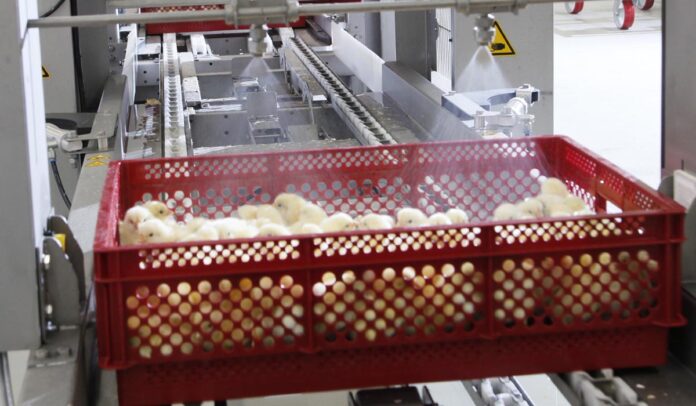
A hatchery got in touch with me recently about a worrying problem: 3-5% of the newly delivered chicks were dying during their first 3-5 days on the farm. As I arrived on site, chick boxes were being loaded onto a truck and even before entering the hatchery the noise was deafening.
The hatchery manager showed me around the hatchery, which was well organised and clean; the routing to the processing room was straightforward and logical. I noticed, however, that most of the doors were open, whereas I would have expected them to be closed. The chick-processing room was separated from the room where chicks were counted, boxed and spray vaccinated.
I stayed a while in the chick-processing room, observing the chicken take-off and selection. The smell was fresh, the chicks looked good and they were quiet. I also noticed that the shells were clean – an indication that pulling time was correct.
The first-class, saleable chicks that had been selected were placed on a conveyor belt, which moved the chicks through to the next room, where they were counted, and spray vaccinated.
After leaving the processing room, where the conditions (temperature and humidity) felt comfortable, entering the ‘boxing’ room was a shock. My immediate reaction was ‘something is wrong here’. First, there was the overwhelming noise made by the chicks in the transport boxes stacked on the trolley, waiting to be transferred to the holding room next door. On closer inspection I could see that these recently vaccinated chicks were soaking wet, all huddled together, and their feet felt really cold. To make matters worse, the trolley was standing directly in a cold draught, caused by a big fan in the corner of the vaccination room. And in the holding room, the temperature was also too low for the chickens that were still wet from vaccination. No wonder the chicks were not happy and were making so much noise!
It didn’t take me long to work out what was wrong in this hatchery. The high levels of early mortality during their first week on the farm were due to the vaccination spray being too heavy, and the wet and under-cooled chicks then being exposed to cold draughts from fans and open doors.
Fortunately, the hatchery technician realised the vaccination error himself, saying: “It’ll only take me a few minutes to change the nozzle for one with a finer spray”. He also reduced the fluid pressure – so that the droplets wouldn’t be too fine and to reduce the amount of water sprayed per chick box. Now the chicks were just damp after spraying instead of being soaking wet.
In the quiet of the canteen we evaluated the early mortality issue. The hatchery manager concluded that early mortality had become a serious problem after the recent annual check of the vaccination equipment – when the spraying nozzles had been exchanged, but not checked afterwards. Since the check, nobody had noticed that the chicks were soaking wet and their body temperature had dropped too low. Despite the noisy protests by the chicks, the dramatic change in viability had come as a surprise.
The hatchery manager realised that everyone had been so busy following protocols as accurately and efficiently as possibly that they had forgotten the other golden rule: look, smell and listen. Take immediate action if you see, smell or hear something abnormal.
A week later I received a short message and a picture of happy chicks on the farm: ‘problem solved’, it said.
















